-

Monthly Economic Report: August 2024
India maintained strong economic momentum in Q1 FY25, with GDP growing at 6.7%. This builds upon a robust cumulative growth of 27% since FY21, demonstrating not just recovery from pandemic losses but transformational changes across productive sectors. All major nonagricultural sectors expanded beyond 5%, indicating broad-based growth, while advancing monsoon and increased kharif sowing brighten agricultural prospects.
The outlook remains positive as public expenditures increase and the rural economy strengthens. At the same time, replenished reservoirs and higher kharif sowing suggest stable food prices. However, the uneven monsoon distribution warrants careful monitoring.
-
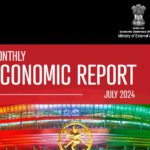
Monthly Economic Report: July 2024
India’s economic momentum continues to hold steady. Despite an unpredictable monsoon, reservoirs have been adequately refilled. The Purchasing Managers’ indices indicate that the manufacturing and services sectors are on an upswing. Tax collections, particularly indirect taxes that mirror economic activity, are showing robust growth alongside a healthy increase in bank credit. Inflation is easing, and exports of goods and services are outperforming last year’s figures. The stock markets maintain their levels, and foreign direct investment is rising, with gross inflows increasing. At this point, the real GDP growth projection of 6.5-7.0% for FY25, as outlined in the Economic Survey for 2023-24, appears to be well-founded.
-
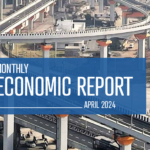
Monthly Economic Report: April 2024
Despite global challenges, India’s foreign exchange reserves are comfortable on the external front, and the Indian rupee has been one of the most resilient vis-à-vis the US dollar in recent months. From the fiscal angle, robust trends in the capital spending of the general government during April-February of FY24, combined with the fiscal consolidation plans reflected in the Budget for FY25, have laid to rest concerns about debt sustainability. Thus, the significant pillars of India’s macroeconomic strength, including growth, price stability, and fiscal management, are directionally positive and mutually reinforcing—the unrelenting geopolitical tensions and volatility in global commodity prices, especially petroleum products, present challenges. However, the expectation is that the macroeconomic buffers nurtured and strengthened during the post-Covid management of the economy will help the Indian economy navigate these challenges reasonably smoothly.
-
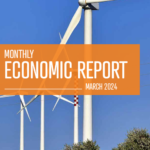
Monthly Economic Report: March 2024
India’s economy remains resilient, driven by strong domestic demand, rural consumption, robust investment, and sustained growth in manufacturing. Projections by RBI and IMF indicate high growth rates, supported by record-breaking stock market performance, remarkable GST collections, and a substantial increase in the manufacturing and services sectors in March 2024. Improved consumer and investor sentiment further enhances India’s ability to navigate global challenges successfully.
-
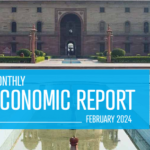
Monthly Economic Report: February 2024
Building on the momentum of the previous two quarters, India’s economic growth surged to a six-quarter high in Q3FY24, exceeding 8% for the third consecutive time. Incorporating updated information, the higher second advance estimate for FY24 economic growth has fueled optimism about the economy. Non-governmental expert agencies have also revised their growth projections upwards. Steady consumption and robust investment activity drive growth, with public investment crowding in private investment. Strong aggregate demand stimulates manufacturing, construction, and related professional, financial, and real estate services
-
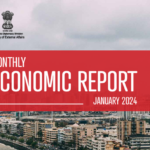
Monthly Economic Report: January 2024
Buoyed by a robust performance in Q2 of FY24 and a growth projection above 7% for the fiscal year, global agencies have upwardly revised India’s growth outlook. Despite increased government spending on capital expenditure, overall expenditure has been reprioritised, evidenced by an improved capital outlay to revenue expenditure ratio. The government’s inclusive approach to economic growth is evident through initiatives for low-income people, women, youth, and farmers while maintaining fiscal consolidation commitments. The fiscal deficit estimate for FY24 has been lowered to 5.8% of nominal GDP, with a further reduction of 5.1% expected in FY25.
-
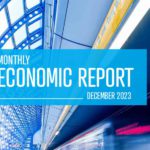
Monthly Economic Report: December
The Indian economy is expected to achieve a growth rate of 7% or higher for FY24, with projections indicating continued growth in FY25 as well. If these projections for FY25 materialize, it will mark the fourth consecutive year of 7% or higher growth post-pandemic. This underscores the resilience and potential of the Indian economy, which bodes well for the future.
The global economy faces challenges in maintaining post-Covid recovery, including supply chain disruptions impacting trade flows, transportation costs, and inflation. However, having faced previous shocks, India expresses quiet confidence in weathering emerging disturbances. Emerging trends include the end of hyper-globalization in global manufacturing, challenges posed by Artificial Intelligence in services trade and employment, and the critical issue of energy transition, with a trade-off between economic growth and environmental sustainability. India is strategically navigating these challenges, emphasizing the need to lower logistics costs, invest in product quality, and transition to greener energy sources.
The Indian economy is better positioned to address these challenges due to policies adopted and implemented over the last decade, with historic infrastructure development and substantial public sector capital investment. The financial sector in India is robust, boasting a solid balance sheet, a willingness to lend, and double-digit non-food credit growth, excluding personal loans.
-
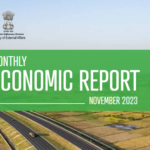
Monthly Economic Report: November
India has emerged as the fastest-growing major economy in H1 of FY24 on the back of resilient consumption and investment. India’s real GDP grew by 7.7% in H1 of FY24, following a 7.6% growth in Q2. The Reserve Bank of India has also raised its growth forecast to 7% for the full year. The strong domestic demand has consequently increased manufacturing and services value-add significantly. Globally, however, trends are slightly different. Geopolitical tensions persist, and a tightened monetary stance has weakened global economic activity. Increases in policy rates have tempered inflation but not enough to lower it to country targets.
-
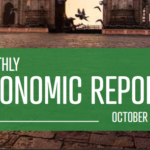
Monthly Economic Report: October
India’s economy remains resilient amidst the global slowdown, supported by robust domestic demand. Major rating agencies express confidence, maintaining a 6.7% growth projection for FY24 and raising the medium-term estimate by 70 basis points to 6.2%. Agriculture sees progress, ensuring food buffer growth, while manufacturing and services sectors expand. Private consumption, especially during the festive season, drives growth, bolstered by savings, low unemployment, and a wealth effect from rising real estate and equity markets—digital transactions surge, indicating a shift towards a cashless economy.
-
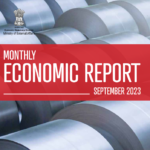
Monthly Economic Report: September
India’s macroeconomic outlook for FY24 is optimistic and supported by strong domestic fundamentals. • Investment demand is rising, and additional growth drivers include broad-based industrial growth and a thriving residential property market. Industrial capacity utilisation has improved, and increased demand for residential properties, combined with public sector capex, strengthens investment. Core inflation is steadily decreasing, and food inflation has eased, though notable challenges exist. Global inflation in 2023 was expected to decline due to the central bank’s tight monetary policies, but challenges arose from geopolitical uncertainties and volatile crude oil prices. Sluggish global demand impacts India’s trade, but recovery is projected in H2FY24. With a lower trade deficit and a comfortable forex reserve position, India’s external account appears robust. RBI’s forward-looking surveys on manufacturing, consumer confidence, employment, and inflation expectations yield optimistic results. Overall, in line with IMF projections, India is poised to remain the fastest-growing major economy in the world in FY24.
-

Monthly Economic Report: August 2023
India’s economic prospects for FY24 remain promising as economic activity maintains momentum. High-frequency indicators suggest that the second quarter of FY24 also shows positive signs. While there was a monsoon deficit in August, it was partially addressed in September, a positive development. The prices of specific food items that contributed to the inflation rate exceeding 7% in July are declining.
The private sector is in good shape, as indicated by data on advance tax payments for the second
quarter, showing that they are actively investing. Although there is a concern about the recent increase in oil prices, it is not yet causing alarm. In summary, the baseline projection for India’s economic growth in FY24 is 6.5% at 2011-12 prices. -

G20 Summit: Global Cooperation and Key Agreements
The G20 Summit, held recently, resulted in a consensus declaration that refrained from condemning Russia for the war in Ukraine. Instead, it emphasised the importance of refraining from using force to acquire territory and focused on broader economic issues. Key discussion areas included trade, technology, tourism, grain/food/energy security, economies and financial markets, climate changes, and health.
-
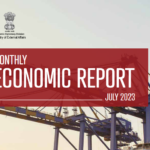
Monthly Economic Report: July 2023
The fourth quarter of FY23 saw stronger-than-anticipated growth, primarily fueled by robust domestic investment. This impressive performance prompted the International Monetary Fund (IMF) to revise India’s real GDP growth projection for FY24 upwards by 20 basis points in its July 2023 World Economic Outlook (WEO).
The strength of domestic investment can be attributed to the government’s unwavering commitment to capital expenditure, poised to be a driving force for future growth. In the FY24 Budget, the Union Government raised capital outlay by a significant 33.3%, increasing the proportion of capital expenditure in total expenditure from 12.3% in FY18 to 22.4% in FY24 (BE). The Union Government’s initiatives have also encouraged states to boost their capital expenditure, with state capital spending rising by an impressive 74.3% year-on-year in Q1 of FY24, complementing the Central Government’s 59.1% increase in the same quarter
-
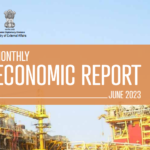
Monthly Economic Report: June 2023
The overall economic situation has stabilized after a year characterized by worldwide uncertainties and fluctuations. Despite lingering uncertainties due to unfavorable geopolitical events, the strain on supply chains has eased, and indications suggest a reduction in inflationary pressures. Risks in the banking sector appear to be under control, and concerns about recessions in most advanced eEconomies are gradually dissipating.
-
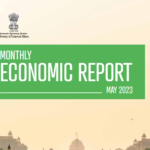
Monthly Economic Report: May 2023
India’s macroeconomic management has been commendable despite unprecedented global challenges and domestic balance sheet issues in the banking and corporate sectors. It has significantly contributed to enhancing macroeconomic stability and enabling a faster recovery compared to other countries.
